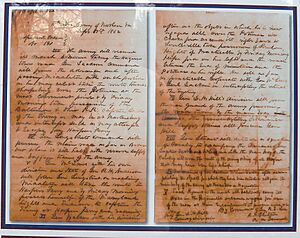Special Order 191 facts for kids
Special Order 191 was a secret plan written by Robert E. Lee in September 1862. It was a handwritten order that explained how Lee's army would move during the Maryland Campaign. This campaign was a big effort to win the American Civil War.
Union soldiers found this important paper. They gave it to Major general George B. McClellan. Getting this order was like finding a treasure map for a general! It showed how Lee had split his army into smaller groups. It also told where each part of his army was supposed to be at certain times.
McClellan usually moved very slowly. But this time, he moved his forces much faster. By September 14, 1862, Lee's original plan was ruined. He now had to react to McClellan's moves. Lee's main goal became trying to save his army from being destroyed.
Contents
Why the Order Was Made
After winning the Second Battle of Bull Run, General Lee decided to invade the North. He hoped that a big victory in the Union states would convince Great Britain and France to help the South. He also thought it might make the North want to end the war. This would help the Confederate States of America become an independent country.
Lee led his Army of Northern Virginia into Maryland on September 4, 1862. He gathered his army near Frederick, Maryland. This town was about 40 miles northwest of Washington, D.C.. The story of the lost order 191 is all about two sheets of paper from this time.
Planning the Attack
On September 7, Lee's army was camped near Frederick. General J.E.B. Stuart's cavalry (soldiers on horseback) were protecting the camp from the Union Army.
Lee met with his generals. He suggested to James Longstreet that they should surround Harpers Ferry Armory. This place had a large Union army group that was a threat to their supply lines. Longstreet disagreed. He said his troops needed rest after their long march. He also thought it was a bad idea to split Lee's army when the enemy was so close. If the Union army found out Lee had divided his forces, they might attack.
Longstreet thought Lee had dropped the risky plan to attack Harpers Ferry. But a day or two later, Longstreet found Lee and General Stonewall Jackson finishing the plan. Longstreet realized the plan was going ahead without him. He reluctantly agreed to it. On September 9, Lee wrote down all the details of this plan in Special Order 191.
What Order 191 Said
Special Order 191 was a detailed plan for how Lee's army would move. It told different parts of the army where to go and what to do.
- General Jackson's troops were to march towards Sharpsburg, Maryland. They would cross the Potomac River and capture the Baltimore and Ohio Railroad. They also had to capture any enemy soldiers at Martinsburg, West Virginia and stop anyone escaping from Harpers Ferry, West Virginia.
- General Longstreet's troops would go to Boonsboro, Maryland. They would wait there with the army's supplies and baggage.
- General Lafayette McLaws and General Richard H. Anderson's troops would follow Longstreet. They would then go to Harpers Ferry to capture the Maryland Heights and the enemy there.
- General John George Walker's troops would cross the Potomac River. They would try to capture Loudon Heights and help McLaws and Jackson stop the enemy from escaping.
- General D.H. Hill's troops would be the rearguard, following the main army.
- General Stuart's cavalry would send small groups with Longstreet, Jackson, and McLaws. The main cavalry group would cover the army's path and gather any soldiers who fell behind.
The order also said that Jackson, McLaws, and Walker's groups would rejoin the main army at Boonsboro or Hagerstown after their tasks were done.
Each of Lee's main commanders received a copy of this handwritten order. General Hill had already been sent one copy directly from Lee. But he also received a second copy from General Jackson. It was this second copy that got lost.
The Lost Order Is Found
On September 13, a Union soldier named Corporal Barton W. Mitchell found something important. He was about 2 miles south of Frederick, Maryland. He found a bundle of cigars wrapped in a piece of paper. This paper was Special Order 191!
The field where it was found had recently been used by Confederate General Hill's troops. The order was even addressed to General Hill. Corporal Mitchell gave the order to his sergeant. It then went up the chain of command (from one leader to the next) until it reached General McClellan.
McClellan's adjutant general, Samuel Pittman, recognized the handwriting. It was from Robert Chilton, who was Lee's adjutant general. So, McClellan had the order in his hands on the same day it was found.
Lee had about 50,000 soldiers, while McClellan had 85,000. But McClellan always thought Lee had 100,000 troops and was very careful about fighting him. Now, McClellan had a chance to destroy Lee's army while it was weak and divided. He just had to act fast. This unexpected piece of information made the usually cautious McClellan attack on September 14. This led to the Battle of South Mountain.
See also
In Spanish: Orden Especial 191 para niños



